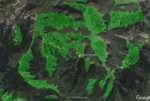Battlehunter
FNG
Alright everybody, as a guy from Michigan that has only hunted out west once, I'm trying to figure out the best way to e-scout for glassing locations. Everything I've found online tells me to get good glass and grid in certain ways, but there isn't much that I've found on how to pick a glassing spot when you're E-Scouting. I'm not worried about shooting a monster elk/mule deer, so my plan is using a set of 10s on a tripod. Any help or personal experiences are much appreciated.
1. What distance are you trying to glass from with 10s? What is too close/far away for the main areas that you are glassing?
2. Would you choose different glassing locations if you were hunting elk vs. mule deer?
3. Are 10's good enough if you don't care how big the antlers are?
4. What are the attributes of a good glassing location?
5. Is there already a good recourse that explains all of this?
6. Attached is a random topo, what locations look like a good place to glass from and why? Each leg of the red line is 1 mile long.
Again, thanks for your time!

1. What distance are you trying to glass from with 10s? What is too close/far away for the main areas that you are glassing?
2. Would you choose different glassing locations if you were hunting elk vs. mule deer?
3. Are 10's good enough if you don't care how big the antlers are?
4. What are the attributes of a good glassing location?
5. Is there already a good recourse that explains all of this?
6. Attached is a random topo, what locations look like a good place to glass from and why? Each leg of the red line is 1 mile long.
Again, thanks for your time!






